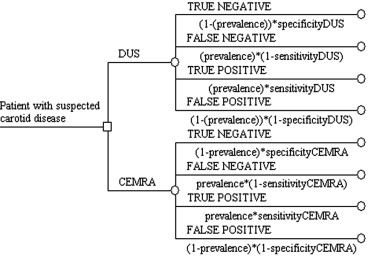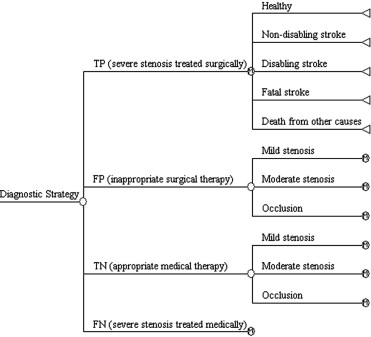Rationale and Objectives
This short report provides a non-technical overview of one emerging modeling technique, discrete event simulation (DES).
Methods
A selective review of the literature that has applied DES methods to evaluate imaging technologies.
Results
Mathematical models to evaluate the likely costs and outcomes of health technologies have become increasingly accepted. Increasing experience has also brought a mounting awareness of the limitations of conventional modeling techniques such as decision trees and Markov processes. Patient-level simulation, including DES, may provide a more flexible approach to modeling for economic evaluation of health technologies.
Conclusions
The strengths of DES suggest that it may have an increasingly important role in the future modeling of annual screening programs, diagnosis, and treatment of chronic recurrent disease and modeling the utilization of imaging equipment.
Over the past 20 years, the use of mathematical models to evaluate the likely costs and outcomes of health technologies has become increasingly accepted. Early examples in the imaging sciences literature include the use of simple decision trees to evaluate the role of CT in the staging of lung cancer ( ) and Markov modeling to evaluate the course of costs and outcomes after screening mammography ( ). Some policy makers, such as the UK National Institute for Health and Clinical Excellence (NICE), now routinely commission independently conducted economic models of new, controversial, drugs, procedures, and imaging technology ( ). These modeling exercises result in a synthesis of the available evidence, an estimate of cost-effectiveness, and a description of the remaining gaps in the evidence. Increasing experience with modeling in health care settings has led to a number of, sometimes discordant, “best practice” guidelines ( ). These guidelines aim to improve the consistency and quality of published models.
Increasing experience has also brought a mounting awareness of the limitations of conventional modeling techniques such as decision trees and Markov models. It is now evident that many clinical problems do not fit comfortably into the framework provided by these techniques and that more flexible methods are required. There are many potential candidates to fill this gap, many of which involve patient-level simulation ( ). The focus of this short report is on one prominent patient-level technique; discrete event simulation (DES). DES is being used more frequently in health care settings, but its use is still far from mainstream ( Table 1 ). A handful of DES studies have now been published in the imaging sciences (6–8). The purpose of this report is to provide a nontechnical primer on the potential role of DES in evaluating imaging technologies.
Table 1
Methods for modeling the costs and outcomes of health care
Year No. of PUBMED citations for Discrete Event Simulation No. of PUBMED citations for Markov Model 2000 3 92 2001 5 97 2002 8 101 2003 6 132 2004 13 190 2005 14 207
Get Radiology Tree app to read full this article<
Limitations of conventional methods
Get Radiology Tree app to read full this article<
Get Radiology Tree app to read full this article<
Get Radiology Tree app to read full this article<
Get Radiology Tree app to read full this article<
Get Radiology Tree app to read full this article<
Get Radiology Tree app to read full this article<
Get Radiology Tree app to read full this article<
Get Radiology Tree app to read full this article<
Get Radiology Tree app to read full this article<
Get Radiology Tree app to read full this article<
Get Radiology Tree app to read full this article<
Discrete event simulation
Get Radiology Tree app to read full this article<
Get Radiology Tree app to read full this article<
Get Radiology Tree app to read full this article<
Barriers to the adoption of DES in medicine
Get Radiology Tree app to read full this article<
Get Radiology Tree app to read full this article<
Get Radiology Tree app to read full this article<
Get Radiology Tree app to read full this article<
References
1. Eddy R.J.: Cost-effectiveness of CT scanning compared with mediastinoscopy in the preoperative staging of lung cancer. Can Assoc Radiol J 1989; 40: pp. 189-193.
2. Rosenquist C.J., Lindfors K.K.: Screening mammography in women aged 40–49 years: Analysis of cost-effectiveness. Radiology 1994; 191: pp. 647-650.
3. Mowatt G., Vale L., Brazzelli M., et. al.: Systematic review of the effectiveness and cost-effectiveness, and economic evaluation, of myocardial perfusion scintigraphy for the diagnosis and management of angina and myocardial infarction. Health Technol Assess 2004; 8: pp. iii-iv. 1–207.
4. Philips Z., Bojke L., Sculpher M., Claxton K., Golder S.: Good practice guidelines for decision-analytic modelling in health technology assessment: A review and consolidation of quality assessment. Pharmacoeconomics 2006; 24: pp. 355-371.
5. Brennan A., Chick S.E., Davies R.: A taxonomy of model structures for economic evaluation of health technologies. Health Econ 2006; August 29
6. Ritchie K., Bradbury I., Slattery J., Wright D., Iqbal K., Penney G.: Economic modelling of antenatal screening and ultrasound scanning programmes for identification of fetal abnormalities. BJOG 2005; 112: pp. 866-874.
7. Stahl J.E., Furie K.L., Gleason S., Gazelle G.S.: Stroke: Effect of implementing an evaluation and treatment protocol compliant with NINDS recommendations. Radiology 2003; 228: pp. 659-668.
8. Stout N.K., Rosenberg M.A., Trentham-Dietz A., Smith M.A., Robinson S.M., Fryback D.G.: Retrospective cost-effectiveness analysis of screening mammography. J Natl Cancer Inst 7 2006; 98: pp. 774-782.
9. U King-Im J., Hollingworth W., Trivedi R.A., et. al.: Cost-effectiveness of diagnostic strategies prior to carotid endarterectomy. Ann Neurol 2005; 58: pp. 506-515.
10. Naimark D., Krahn M.D., Naglie G., Redelmeier D.A., Detsky A.S.: Primer on medical decision analysis: Part 5, Working with Markov processes. Med Decis Making 1997; 17: pp. 152-159.
11. Eddy D.: Bringing health economic modeling to the 21st century. Value Health 2006; 9: pp. 168-178.
12. Gorelick P.B.: Carotid endarterectomy: Where do we draw the line?. Stroke 1999; 30: pp. 1745-1750.
13. Brown J.B., Palmer A.J., Bisgaard P., Chan W., Pedula K., Russell A.: The Mt. Hood challenge: Cross-testing two diabetes simulation models. Diabetes Res Clin Prac 2000; 50: pp. S57-S64.
14. Briggs A., Sculpher M.: An introduction to Markov modelling for economic evaluation. Pharmacoeconomics 1998; 13: pp. 397-409.
15. Barton P., Bryan S., Robinson S.: Modelling in the economic evaluation of health care: Selecting the appropriate approach. J Health Serv Res Policy 2004; 9: pp. 110-118.
16. Reina-Gutierrez T., Serrano-Hernando F.J., Sanchez-Hervas L., Ponce A., Vega de Ceniga M., Martin A.: Recurrent carotid artery stenosis following endarterectomy: natural history and risk factors. Eur J Vasc Endovasc Surg 2005; 29: pp. 334-341.
17. Kelton D.W., Sadowski R.P., Sturrock D.T.: Simulation with arena.2006.McGraw-HillNew York:
18. Caro J.J.: Pharmacoeconomic analyses using discrete event simulation. Pharmacoeconomics 2005; 23: pp. 323-332.
19. Rothwell P.M., Warlow C.P.: Prediction of benefit from carotid endarterectomy in individual patients. Lancet 1999; 353: pp. 2105-2110.
20. Schillinger M., Exner M., Mlekusch W., et. al.: Acute-phase response after stent implantation in the carotid artery: Association with 6-month in-stent restenosis. Radiology 2003; 227: pp. 516-521.
21. Hollocks B.W.: Forty years of discrete-event simulation—a personal reflection. J Oper Res Soc 2005; advance online publication: 1–17
22. Fendrick A.M.: The future of health economic modeling: Have we gone too far or not far enough?. Value Health 2006; 9: pp. 179-180.
23. Hammerschmidt T., Goertz A., Wagenpfeil S., Neiss A., Wutzler P., Banz K.: Validation of health economic models: The example of EVITA. Value Health 2003; 6: pp. 551-559.
24. Eddy D.M., Schlessinger L.: Validation of the archimedes diabetes model. Diabetes Care 2003; 26: pp. 3102-3110.
25. Griffin S., Claxton K., Hawkins N., Sculpher M.: Probabilistic analysis and computationally expensive models: Necessary and required?. Value Health 2006; 9: pp. 244-252.

